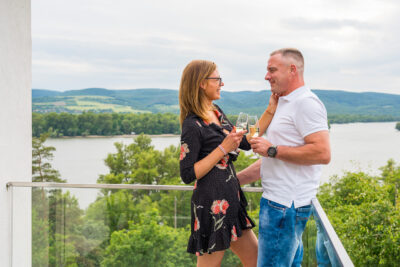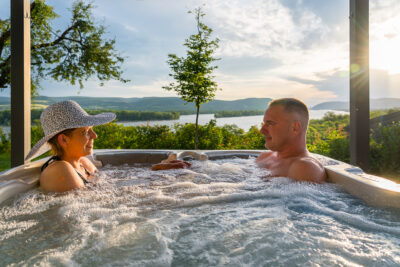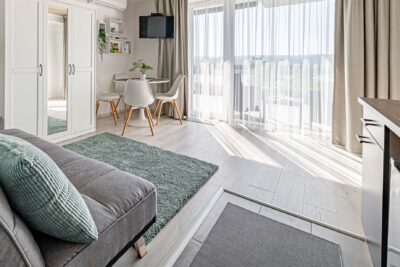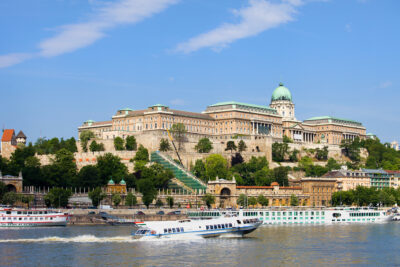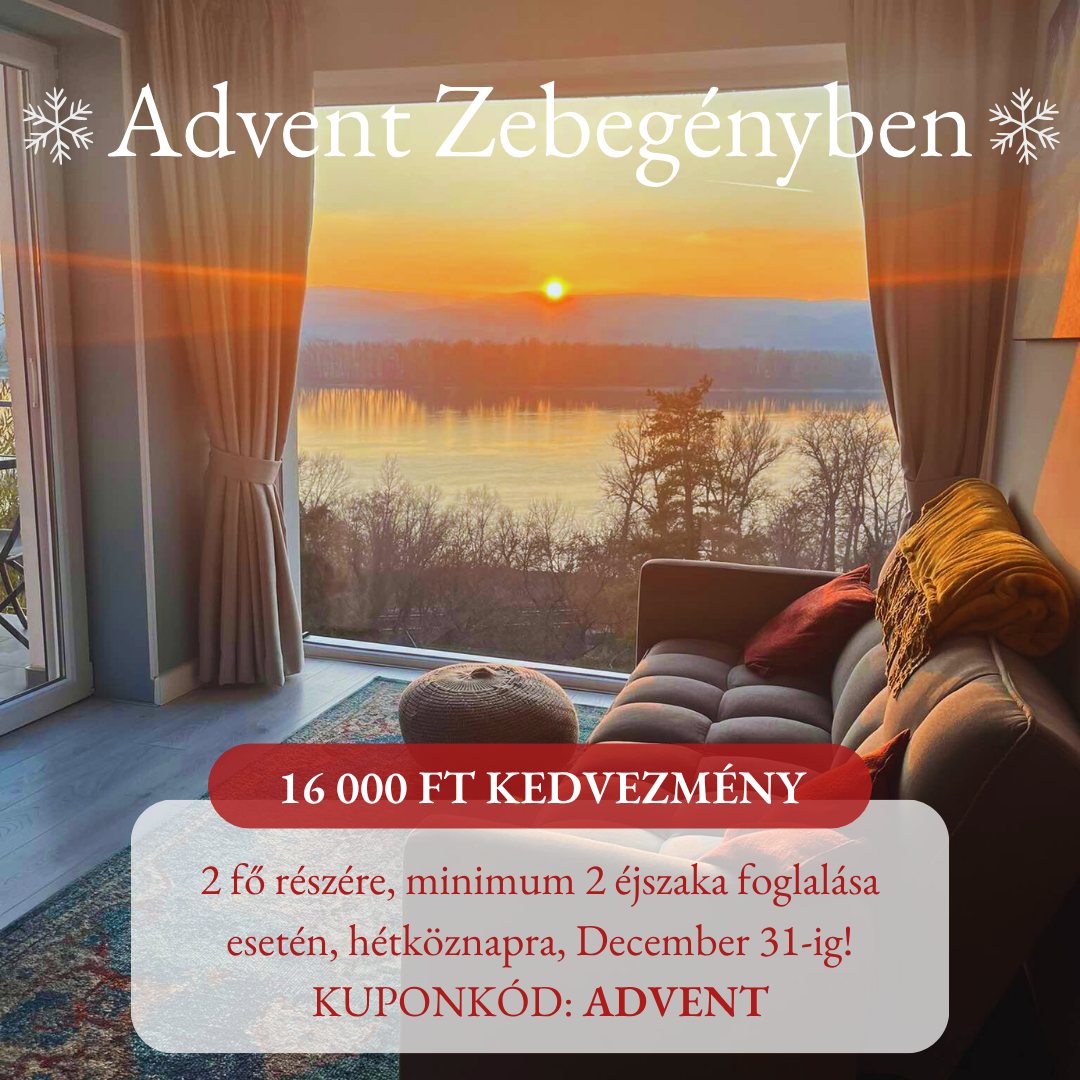Zebegény, in the heart of the Danube bend, offers many attractions for nature and culture lovers
If you are planning to explore this magical village or just want to know more about it, you are in the right place! In this post, we've collected the most interesting sights in Zebegény to guarantee you an unforgettable experience. We now invite you to discover this magical village in this post.
12 attractions: more than just a destination
The charm of Zebegény is that everyone can find something to do here, whether it's a quiet break in the countryside, a cultural experience or active recreation in the great outdoors. Discover the town for yourself through its attractions and immerse yourself in the magical world of this special place!
Assumption of the Blessed Virgin Mary of Snow Parish Church

A unique work of 20th century church architecture is the Hungarian Art Nouveau parish church dedicated to the Blessed Virgin Mary of Snow. Built between 1908 and 1910, it was designed by Károly Kós, Dénes Györgyi and Béla Jánszky. The Hungarian style, represented by the young architects of the early 20th century, is evident not only in the design of the building, but also in the interior painting and furnishings. Its furnishings and stained glass windows were designed by Károly Kós.
His frescoes were painted between 1910 and 1914. They depict Constantine the Great's vision of the triumph and exaltation of the Holy Cross in honour of the 1600th anniversary of the event. The frescoes were designed by Aladár Körösfői-Kriesch, a painter and teacher at the Gödöllő Art School, and were painted by György Leszkovszky, an assistant teacher, and his students.
For the 2010 centenary, the church was completely renovated and the façade decoration from the original Kós plans was completed, so that this landmark can be seen in its full splendour in the main square of the village. The statue of St Elisabeth of the House of Árpád, by the architect and sculptor Géza Maróti, which originally decorated the garden of the Maróti villa, is located next to the long wall of the church. When the villa was nationalised, the people of Zebegény took it under the protection of the church.
Trianon Monument

Architect and architect Géza Maróti designed the "National Flag" and the "Heroes' Monuments" on the Kálvária Hill so that the whole ensemble ("Memorial of National Tragedies") could be seen from several kilometres away from the Danube.
In the 1960s, the national flag building was converted into a lookout, and its original function was silenced. In 1996, a memorial plaque was placed on one of the pillars, recalling the Trianon Peace Treaty, and the restoration of the complex began.Since the turn of the millennium, it has once again served as a Trianon memorial site.On 4 June 2000, it was inaugurated at an official commemoration ceremony, and soil from various regions of historic Hungary was placed at its base.
The "Bell of National Remembrance" was consecrated in the Calvary Chapel at the other end of the memorial complex. The national flag rises from the central pillar of the memorial, while the four surrounding stone pillars are topped with metal spheres with double crosses, reminiscent of the national flag.
Museum of Maritime History
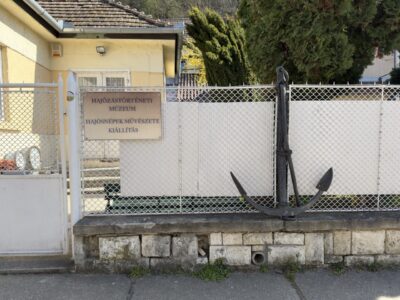
Captain Vincze Farkas opened the first private museum of Hungarian maritime history in Zebegény. Its aim was to present the maritime and river navigation of our country in a different way. During his voyages and from friends and colleagues who had sailed at sea, he had collected souvenirs and nautical equipment over several decades, which he supplemented with objects of his own making.
The Maritime History Museum traces the development of shipping from prehistoric times through the Middle Ages to the present day. As well as objects, equipment and tools related to shipping, visitors can admire taxidermy of sea and land creatures. There are also guided tours on the history of technology, geography, history, natural history and ethnography.
The attraction at 9 Szőnyi Street can be visited every year from 1 April to 31 October: 10 am to 4 pm, from 1 May to 30 September: 9 am to 5 pm. Closed on Mondays, except on public holidays. It is also open at other times by prior arrangement.
István Szőnyi Memorial Museum
István Szőnyi (1894-1960), an outstanding figure of 20th century Hungarian painting, lived and worked in Zebegény from 1924 until his death. It was here that his art came to full fruition, his painting inspired by the magical beauty of the landscape and the people living in the village.
Today's István Szőnyi Memorial Museum is the painter's former residence and studio, which has been open to the public since 1967. The aim of the founders was to preserve and present Szőnyi's works as faithfully as possible, and to show the environment in which they were created.
Visitors to the museum can have the rare experience of entering a world that no longer exists, of getting to know relics of the workshop and the studio that are otherwise closed to the public, and of feeling the spirit of the place. In the museum, visitors can see the paintings in the space where they are most authentic: the place where they were born.
Opening hours of the Szőnyi István Memorial Museum:
1 March to 31 October: 10:00-18:00, except Mondays
From 1 November to 28 February: Saturdays and Sundays only, 10:00-16:00
Address: 2627 Zebegény, Bartóky utca 7.
Seven-hole bridge - "Bridge of seven"
When Hungary's first railway line was extended, the Vác-Párkánynána railway line was built, several stations and viaducts were built, including the seven-hole bridge in Zebegény. Construction work was carried out under the supervision of Italian specialists from 1846 to 1850. Originally designed for one track, it was extended to two tracks to cope with increasing traffic and transport needs.
The "Seven Bridges", as the people of Zebegény call it, with its seven-arched vault is a railway historical curiosity, the second largest in our country after the Hortobágy Bridge. The sight was declared a monument in 1965 because of its importance.
Sunflower Houses
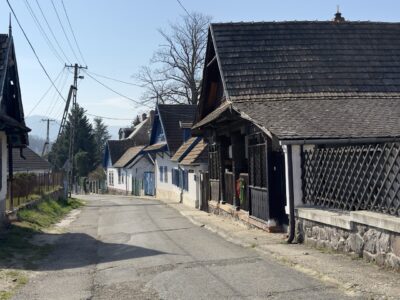
Passing under the arcades of the Seven Bridges, on the former main road of the village, you can see the Sunflower Houses overlooking the Danube, where Gr. Lászlóné Károlyi - née Gr. Franciska Apponyi, née Franciska - used to run a children's paradise. The blue-painted Danube-side "Flower Niches", designed in 1936 in the style of Hungarian folk art, are attributed to the Countess.
A well-kept garden and a beautiful beach awaited holidaymakers at that time. It was his initiative that the Flower Association of Zebegény (VEZ) was founded and educated children in the love of nature, who named flowers, trees, shrubs and birds.
The Countess was the soul of the VEZ: the Sunflower. She hosted teachers who taught the children to knit, sew, sing, recite poetry, dance and behave, thus forming them into a community.
As a result of his work, the village became the "centre of the world" in the 1930s, with hundreds of foreign guests visiting the village to study his pedagogical methods. He was the founder of the Sunflower Wolf Pack in Zebegény and the Gr. Albert Apponyi Scout troop, and it was through his intercession that the "Golden Train" carrying the right hand of St. Stephen stopped here for a few minutes.
Maróti villa
Géza Maróti (1875-1941) architect, sculptor, one of the exceptional artists of the Hungarian Art Nouveau. His works include the construction of the Hungarian pavilion at the Venice Biennale and the interior design of the National Theatre in Mexico City.
He discovered the beauty of Zebegény at the turn of the century, and several of his works can still be seen in the village. He rented a summer house for a few years, and in 1913 he built his own villa with an adjoining studio (in today's Napraforgó Street) on the banks of the Danube.
It was in this villa that he collected his architectural and sculptural ideas, scattered all over the world.He spent all his time here between 1937 and 1941, and in his autobiography he proudly declared himself an "ancestral bourgeois".
After the nationalisation of the building in the 1950s, it served as a maternity home and internal medicine ward of the hospital in Vác. In the 1990s, it was privately owned and renovated, so visitors can admire it from the banks of the Danube or from Napraforgó Street.
Dőry Castle

The aristocratic cheese-maker's widow, Baron Vilmos Vilmosné Dőry, had the eclectic-style mansion and farmhouse built on the banks of the Danube in the 1910s. The Dőry family had their rooms on the ground floor of the building, while the upstairs was reserved for their distinguished guests during the summer. The tower room on the right side of the castle offers a magnificent view of Zebegény, the Danube and the surrounding hills.
The stables and the servants' quarters were in the farm building next to the castle. The chapel of St. Elisabeth, which stands in front of the building, was built by Gr. The chapel was erected by Mrs. Laszlo Károlyi in 1938. The castle has been privately owned in recent years, so it is not open to visitors.
Tobacco Pavilion
Climbing up from the Seven Bridges to the János Hill, you can enjoy a beautiful panorama, where the former Tobacco Pavilion, originally the tobacco hall of the 1896 Millennium Exhibition, rises imposingly above the village. After the exhibition, it was transported to Zebegény and rebuilt for the Children's League.
For 100 years, the building was used as a children's playground, providing a summer home for thousands of city children during their camping holidays. After the war, the Ferenc József Holiday Children's Village became the Children's Village of the Metropolitan Council, where orphans and children in state care spent their holidays until the 1990s. Unfortunately, the building has now lost its former glory along with the children's clamour.
Cemetery
In the beautifully situated cemetery, the parish has created a special "German memorial" with old Swabian gravestones.
In 1945, the Soviet troops deported the population of German origin from our country as collective punishment for two weeks' work, the "Malenky robot". The 2 weeks turned into 2-3 years, a horrible camp life, hard, sweaty work, hunger, humiliation and inhuman treatment became their class lot on Russian soil.
Many of the displaced have never returned home, and are buried in unknown, unmarked graves near the Donetsk coal beds. The 111 deportees from Zebegény are commemorated by a headstone erected in front of the church in 1989.
From the cemetery, 9 staircases - built in the mid-19th century by Zebegény families - lead up to the Calvary. Here stands the Calvary Chapel, built in 1853
Rock Chapel
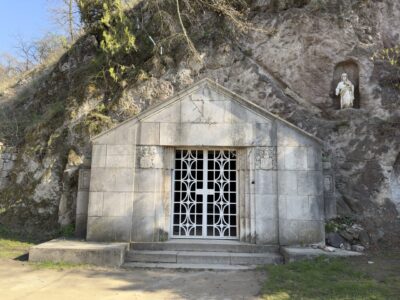
At the bottom of the Calvary Hill, along the serpentine, is the Chapel of the Rock, where legend has it that a hermit once lived. His work is the beautiful stone relief on the right side of the cave, depicting the Coronation of the Virgin Mary and the Holy Trinity.
After the hermit's death, the cave was enlarged and converted into a church. In the late 1770s, the cave was used as a sanctuary for the church that was already standing.
After the demolition of the Old Church decades later, in 1938, László Jékey and Magda Bartóky built the ornate, emblazoned façade with the wrought iron gate, still visible today, based on the designs of Antal Hendrich.
Next to the chapel, the hermit's tomb is buried in the hillside. A litany is celebrated here on 5 August, the day of the Feast of the Farewell, and a life-size nativity scene is displayed in the chapel during Advent.
Kós Károly Lookout
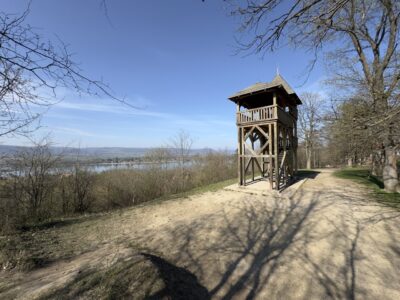
Next to the Trianon Monument, the Kós Károly Lookout, inaugurated in the summer of 2015, can be found on the Zebegény hill. It was designed by Árpád Csóka, and its construction resembles a church. The lookout is named after Károly Kós, and the lower part of the red pine tower forms a Székely gate, paying homage to the architect's Transylvanian origins.
From the lookout you can enjoy a wonderful view of Zebegény, the Danube and the Pilis. The monument and the lookout are located a few minutes walk from the main square of Zebegény, so it is easy to visit even with small children.
Discover the magic of Zebegény first hand
Book your accommodation in the Watercolour in Apartment House, and enjoy the closeness of nature in a luxurious setting. Perfect if you want some peace and quiet and fresh air, all in comfortable and stylish accommodation.

